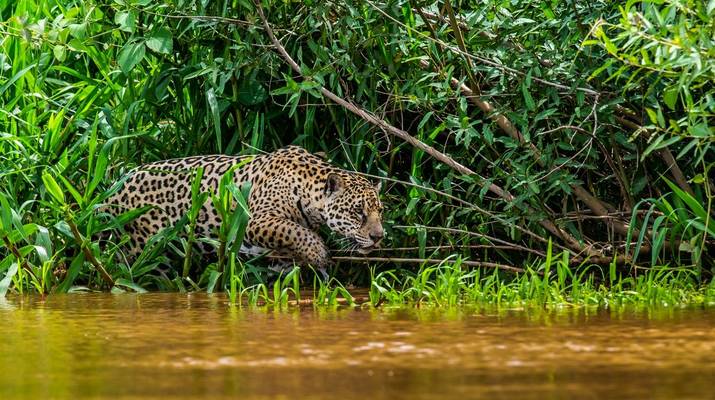The Amazon Rainforest






The Amazon needs no introduction. The largest and best-known tropical rainforest of all, which covers an astonishing five and a half million square kilometres of northern South America, harbours by far the greatest concentrations of biodiversity on Earth. Representing more than half of the planet’s remaining tropical rainforests, the Amazon supports a riotous abundance and variety of life that defies almost all description. Its dark, tangled jungles contain an estimated 390 billion individual trees of over 16,000 species, more than 1,100 of which have been recorded in a single quarter square kilometre; the UK has fewer than 100 native trees in total. Living amongst them are approximately 400 species each of mammal, reptile and amphibian, along with more than 2,000 fish and 1,300 birds. The diversity of some groups is so overwhelming that we may never fully understand it – the number of insect species, for example, could reach well into the millions. All in all, some 10% of Earth’s known species can be found in the Amazon. Remarkably, this extraordinary profusion of life is largely fertilised by phosphorous-rich dust from the Sahara Desert in Africa, 30 million tons of which are carried to the forest each year by transatlantic winds.
Speak with our Amazon Rainforest specialist

The Wildlife of the Amazon
It’s hard to beat the Peruvian Amazon for that sense of pristine wilderness harbouring macaw clay clicks and exciting mammals (see here and here). The best lodges along eastern Ecuador’s Napo river (Andes & Amazon and Ecuador's Mammals) offer a polished service in fantastic upper Amazonian habitat while our Brazilian Amazon holiday gives a different perspective from a thousand miles or so downstream this great river system.
Operations Manager - Andy TuckerThe Wildlife of the Amazon
The Amazon spans no fewer than nine South American countries, with Brazil containing the greatest part of the forest. Despite its abundance, wildlife is typically elusive and hard to see amongst the dense tropical vegetation. However, there are particular areas across several nations, in particular Brazil, Peru and Ecuador, where the chances of superb encounters with the region’s most charismatic fauna are especially high. One such area can be found in the southern part of the Amazon, around the Brazilian forest reserve of Fazenda São Nicolau. Here, an extensive network of forestry trails provides access to unparalleled concentrations of mammals and birds, including such spectacular species as Harpy Eagle, Brazilian Tapir, several species of gaudy macaws, and four stunning and rare primates: Grey Woolly Monkey, Black-faced Spider Monkey, Red Howler Monkey and the striking White-nosed Saki. Of all these, it is perhaps the majestic Harpy Eagle that represents the greatest prize – this part of Brazil supports some of the highest known breeding densities of this peerless predator, meaning that there are often opportunities to view active nests. There are few sights in nature more awe-inspiring than that of an adult Harpy bringing a sloth or monkey back to its young, which can stay around the nest for up to a year after fledging. Elsewhere in the Amazon, such privileged encounters are practically unheard of, but here they can be almost guaranteed thanks to the expertise of local guides.
Over 500 other bird species have been recorded in the reserve, including Blue-and-yellow and Red-and-green Macaws, a stunning variety of hummingbirds and the exquisite Pavonine Quetzal. Mammals can be more challenging to locate, but there is a good chance of Brazilian Tapir, Collared and White-lipped Peccaries, along with the possibility of Neotropical and Giant Otters, and even Jaguar on boat trips on the Juruena River.
In fact, taking to the water is often the most productive approach to viewing animals in the Amazon. Never is this more true than when embarking upon a week-long cruise down the Rio Negro, further north in Brazil. This river, one of the largest tributaries to the Amazon itself, provides access to a vast area of wildlife-rich forest, including the phenomenal Anavilhanas Archipelago and Jau National Park. The former is the world’s largest freshwater archipelago, spanning over 300,000 hectares of marshes and forest-clad islands. It is a natural paradise, best explored by canoe, where Agami Heron, Festive Parrot and Amazonian Umbrellabird are common, alongside habituated pods of pink Amazon River Dolphins. After dark, spotlighting along riverbanks can reveal Spectacled and Black-banded Owls, Great and Common Potoo, Brown-throated Sloth and other more unusual mammals. Jau National Park, meanwhile, protects a remarkable 14 species of primate, including the stunning Golden-backed Uakari, alongside birds such as Great Jacamar, Guianan Toucanet and King Vulture.
The second greatest swathe of Amazonian forest is found in Peru, which offers its own unique opportunities for wildlife-viewing. One of the most productive areas can be accessed from the renowned Amazon Rainforest Conservation Centre (ARCC), deep in the jungles of the state of Madre de Dios. Here, 17,000 acres of pristine habitat surround Lake Soledad, a magnet for living creatures of all kinds, providing some of the best mammal- and bird-watching in all the Amazon. Although they can remain elusive, ARCC is surrounded by some of the highest mammal densities in South America. The lake is home to obliging Giant Otters, Black Caiman and Green Anaconda, while trees overhanging the water play host to up to eight species of monkey, amongst them the common Brown Capuchin and acrobatic Black Spider Monkeys. As in Brazil, taking to the water can often be the best way of getting up close with these and other species, including the lake’s astonishing birdlife, which is easily visible from ARCC’s dedicated catamaran. Scarlet Macaw, Cuvier’s Toucan, Agami Heron, Sungrebe, Black-collared Hawk and Green-and-rufous Kingfisher are all delightfully visible, alongside the bizarre Hoatzin, whose young possess reptilian claws for clambering through lakeside vegetation.
Moving deeper into the forest, away from the lake, brings a chance of more retiring creatures. Mammals lurking in the shadows include Tayra, Brown Agouti, huge herds of White-lipped Peccary, and even Jaguar, while nocturnal expeditions can reveal Nine-banded Armadillo, Red Brocket Deer and Night Monkey. Although birding can be a challenge amongst the tightly packed trunks and thick canopy, ARCC’s fantastic 35-metre-high platform allows visitors to enjoy eye-level views of typically hard-to-spot wildlife. This can include such marvellous species as Blue-and-yellow Macaw, Bare-necked Fruitcrow, Paradise Tanager and Crimson-crested Woodpecker, as well as more primates like the beautiful Red Howler Monkey. Nearby, hides positioned at clay-licks overlook daily gatherings of Red-and-green Macaws, which eat the soil to neutralise toxins found in their seed-rich diet.
Although Ecuador contains only a small fraction of South America’s rainforest, it is nevertheless a superb country for experiencing the Amazon. The River Napo is Ecuador’s principal Amazonian tributary; this great winding waterway borders the vast Yasuni National Park, which at over 10,000 square kilometres is amongst the best forest reserves on the continent. Deep within the park is the Napo Wildlife Centre (NWC), which is co-owned by the local community and surrounded by an abundance of wildlife, including no fewer than 565 species of birds. Here, too, are astonishing parrot clay-licks, where under ideal conditions up to 800 individual birds of over 10 species can be present at any one time. Within the lodge grounds, enchanting groups of Golden-mantled Tamarin can be encountered, while a canopy tower in a more distant part of the forest provides an unforgettable dawn spectacle, with troops of monkeys, placid Three-toed Sloths and a riotous assemblage of birds. Some of the avian highlights of the Ecuadorian Amazon are Fiery Topaz, Spotted Puffbird, Casqued Oropendola, Yellow-backed Tanager and Great Tinamou, whilst this area is also amongst South America’s best for locating various exciting reptiles and amphibians, such as Yellow-footed Tortoise, Rainbow Boa and Two-striped Forest Pit-viper.
The vast expanse of rainforest that is Amazonia contains such great concentrations of wildlife, and so many unique places for viewing it, that the descriptions above do not even begin to do justice to the region’s endless potential. However, each destination still offers a tantalising and unparalleled taste of the jungle’s fascinating natural history. Wonderfully, each country also offers convenient access to other habitats; in Brazil, a visit to the Amazon can be combined with the Pantanal, where viewings of Jaguars and other large neotropical mammals are practically guaranteed. Both Ecuador and Peru have the Andes, where endemic birds and iconic creatures, including Spectacled Bear and Mountain Tapir, can be found, alongside cultural highlights such as Machu Picchu. Even without these nearby attractions, the Amazon is a wildlife-viewing destination like no other, and cannot fail to induce a lifelong fascination.



 Loading search...
Loading search...
























